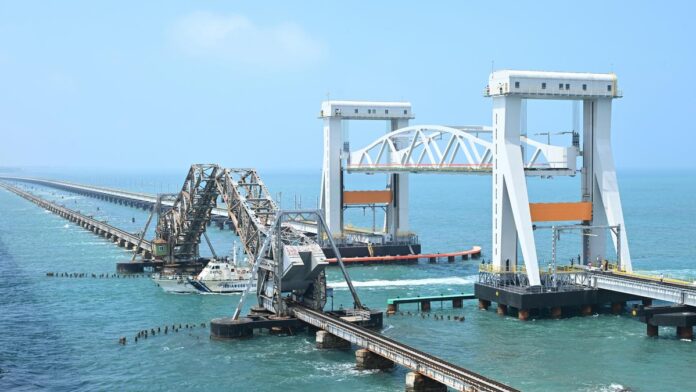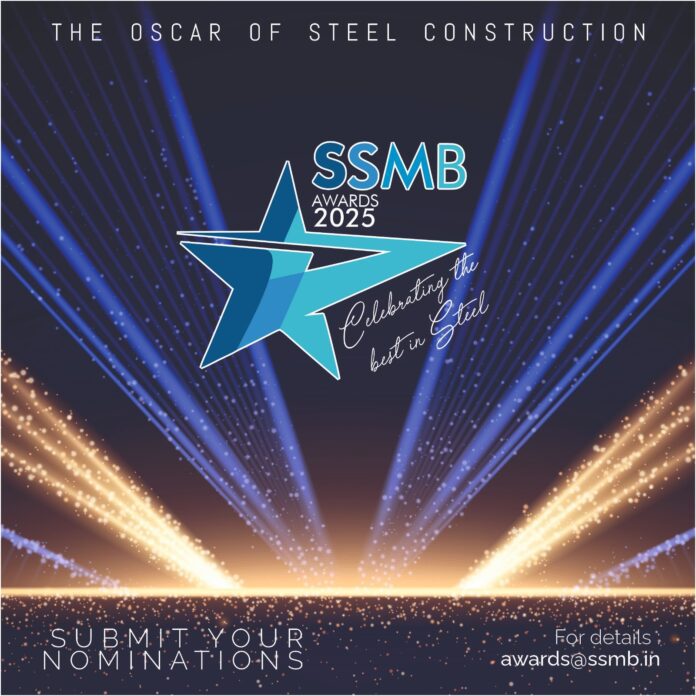Hook:
From the Himalayan heights to cyclone-battered coasts, India’s bridges are carrying more than just vehicles, they carry the weight of resilience.
Introduction: From the Himalayan heights to cyclone-battered coasts, India’s bridges today are far more than structural connectors, they are embodiments of resilience, adaptability, and engineering foresight. At the center of this transformation lies steel, a material that is enabling India to span extremes in geography, climate, and time, while keeping pace with policy priorities, economic imperatives, and climate realities.
India is at the precipice of an unprecedented transportation revolution. At its very heart lie bridges, transforming from simple crossing structures into vital arteries of the nation’s economic and strategic infrastructure. Today, a modern bridge is a testament to engineering resilience, a structure designed to stand unyielding against the harshest forces of geography, climate, and the relentless march of time. This story explores how India is now consciously moving beyond mere connectivity to construct future-ready bridges that effectively withstand the multi-pronged challenges of seismic risks, monsoonal floods, marine and atmospheric corrosion, and extreme weather variability.
CONTEXT AND THE ROLE OF STEEL
Bridges are the foundational elements of India’s most ambitious projects, including economic corridors, smart cities, and border infrastructure. The pivot towards steel bridge construction is driven by its inherent advantages in speed, strength, modular adaptability, and life-cycle benefits.
The long-term shift toward steel is driven by a stark comparison with traditional methods. Bansh Narain Singh, Principal Advisor, Rail Vikas Nigam Ltd., explains the inherent limitations of Reinforced Cement Concrete (RCC) structures: “While RCC bridges have been widely used in India, they face inherent limitations in terms of weight and span constraints, time-consuming construction, and durability issues, especially prone to cracking and corrosion of reinforcement in aggressive environments. Steel bridges, in contrast, offer clear superiority: faster construction, suitability for longer spans, better performance in seismic and wind conditions, and are 100 per cent recyclable.”
Rakesh Chopra, National Head – Sales, Apex Buildsys Limited, adds that Pre-Engineered Steel Systems (PEB) dramatically enhance resilience through precision: “The essence of PEB lies in bolted connections, which not only simplify assembly but also provide flexibility under dynamic forces such as wind loads, seismic tremors, and tidal effects. This structural logic allows bridges to absorb shocks, distribute loads evenly, and maintain performance even in extreme terrains.”
ENGINEERING AGAINST GEOGRAPHY
Resilience begins with conquering geography. India’s diverse topography from young, seismic mountains to expansive coastal marshlands demands bespoke, high-end engineering solutions.
“Steel bridges are no longer just connectors, they are symbols of resilience, adaptability, and national progress.”
| Case Studies in Extreme Terrains
1. The Himalayan Giant: Chenab Bridge (Jammu & Kashmir) This structure, the world’s highest railway bridge, sits in Seismic Zone V. Shashank Rajbhoj, General Manager (Design), Afcons Infrastructure, cites it as a prime example of overcoming extreme conditions: “The Chenab Bridge required crossing the Chenab River with a steel arch spanning 467 m. Designed for Seismic Zone V in a hilly terrain and considering high wind speed at the altitude of 359 m, it stands as one of the most complex bridges built in recent times. The steel superstructure has also been engineered to withstand a blast load of 40 kg TNT equivalent acting on the deck.” 2. The Brahmaputra Lifeline: Bogibeel Bridge (Assam) Built in Seismic Zone V and crossing the braided, high-volume flow of the Brahmaputra, this rail-cum-road bridge used a resilient steel truss design. It, along with the Mokama Bridge in Bihar, demonstrates how steel is crucial for durable, faster, and large-scale construction in flood-prone zones, according to Shashank Rajbhoj. 3. Conquering the Marine Environment: New Pamban Bridge (Tamil Nadu) The new railway bridge replacing the historic structure is a testament to marine resilience. As noted by Bansh Narain Singh, “Designed to withstand cyclonic winds, corrosive marine environment, and navigation requirements, this bridge features India’s first vertical lift span.” The challenge of corrosion in such coastal environments is significant. Atul Bhobe, Managing Director, TPF Engineering, affirms this challenge: “Corrosion due to the proximity to the sea is a major issue in deciding the usage of steel. At the same time, high seismic zones are ideal for the usage of steel because of the lighter weight which generally makes the structure economical.” |
Insights into Design Innovation and Standards
The core of structural resilience lies in advanced material science and engineering practices. Indian standards are now globally competitive. Atul Bhobe confirms: “Almost all provisions are at par for all these issues. These are well addressed by Indian codes, specifications, engineering practices and industry standards.”
|
Breaking Barriers in Terrain
|
CLIMATE & DURABILITY CHALLENGES
Beyond immediate geographic threats, the long-term resilience of steel bridges hinges on mitigating the accelerating risks from climate change and environmental degradation.
Tackling Corrosion and Fire Risk
Corrosion remains the single biggest threat to the longevity of steel infrastructure.
- Protection Systems: The industry relies on highly controlled, off-site application of protective systems. Shashank Rajbhoj explains the rigorous process: “Steel is typically fabricated in workshops, where it is treated with protective paint systems or galvanisation as per contractual requirements and in accordance with the specified environmental exposure conditions, rather than being applied on site. Fire resistance is addressed by applying fire-retardant coatings, encasement systems, or passive fire protection measures as per design requirements.”
- Adaptation: Railways and highway authorities are actively strengthening resilience. Bansh Narain Singh highlights the strategy: “MoRTH advisories (2020 & 2022) are mandating climate risk mapping. This is complemented by RDSO guidelines on corrosion protection, wind-resistance, and seismic detailing, along with the use of weathering steel, corrosion-resistant alloys, and epoxy coatings to extend life cycles in coastal/humid areas.”
Policy Push for Climate Adaptability
The shift is integrated into the operational core of infrastructure agencies. Manjul Mathur, Retired General Manager, Rail Coach Factory, Kapurthala, details the steps taken by Indian Railways: “Railways are increasingly integrating climate-risk thinking into design and asset management. IR is striving to become a ‘Net Zero’ entity by 2030 by completing electrification, improving energy efficiency, and contributing to carbon sinks through tree plantation.”
“Resilience in modern bridges means withstanding earthquakes, floods, corrosion, and even the test of time.”
SPEED VS. SAFETY: THE BALANCING ACT
The core tension in infrastructure development is balancing the national drive for rapid execution with the uncompromising need for long-term structural safety. The use of modular and prefabricated systems is the primary answer.
The Power of Modular Construction
Rakesh Chopra explains the practical solution from an erection standpoint: “Speed and safety need not be conflicting priorities. PEB solutions emphasise modularity, standardising bridge components. This approach enables simultaneous off-site fabrication and on-site foundation work, drastically reducing project timelines. At the same time, factory-controlled quality ensures high precision and reliability of each component.” He also highlights a key design lesson: “An erection-friendly design with minimised welds on site and simplified bolted connections saves time, enhances safety, and improves overall quality.”
Shashank Rajbhoj notes this transformation: “The use of modular steel and fabricated systems is transforming bridge construction in India by enabling faster execution with reduced on-site activities. Off-site fabrication ensures superior quality control, precise tolerances, and effective corrosion protection.”
This modular approach is crucial for strategic connectivity in extreme terrains, directly supporting operational preparedness and self-reliance along the borders.
In a landmark achievement showcasing the synergy between operational requirement and the Aatmnirbharta drive, the Border Roads Organisation (BRO) integrated with an Indian manufacturer to launch the first ever indigenously developed 140 ft double lane modular steel bridge at an altitude of 11,000 ft on the Flag Hill-Dokala Road in Sikkim. This Class 70 bridge, which caters for the terrain and weather peculiarities of its intended area of use, was found to be particularly suitable for launch in mountains and high-altitude areas.
The bridge’s rapid deployment and success solidified a strategic partnership. The BRO and Garden Reach Shipbuilders & Engineers (GRSE) subsequently signed an MoU in March 2022 for the fabrication and supply of 27 such double lane modular bridges. One of the most critical advantages of this collaboration is the time factor, as these bridges can be launched within 45 days of handing over the site by the units.
This modularity is explicitly supported by railway standardisation. Bansh Narain Singh points out the foundational role of the Research Designs & Standards Organisation (RDSO): “RDSO has played a pivotal role in promoting resilient steel bridges by preparing standard drawings for Plate Girders, Open Web Girders, and Composite Girders across a wide range of standard spans. Such standardisation allows faster approvals, easier fabrication, and uniform quality across the country.”
Innovation as the Answer
For experienced engineers, rapid construction is not a necessary compromise, but a spur for innovation. Atul Bhobe believes: “Continuous innovation in engineering design and construction is the only answer to balancing the pressure for rapid construction timelines with the need for safety and durability.”
Manjul Mathur adds a practical perspective, underscoring the structural benefits: “Steel is uniquely well-suited where resilience and speed of delivery matter: it enables long clear spans (reducing piers in floodplains), highly prefabricated modular construction (cutting site time), and controlled quality with repeatable shop fabrication.”
“Corrosion remains the single biggest threat to the longevity of steel bridges and the battle is being won with advanced coatings and smart materials.”
|
Steel’s Speed Advantage
|
THE POLICY & INDUSTRY LENS
The sheer scale of bridge construction is a direct outcome of cohesive government policy driving infrastructure spending.
Policy Driving Scale and Resilience
The integrated approach under major programs is accelerating resilient construction. Bansh Narain Singh details the foundational programs:
- PM Gati Shakti National Master Plan: Integrates highways, railways, and ports, viewing bridges as critical links. It uses a geospatial platform to cut planning time and identify infrastructure gaps.
- Bharatmala Pariyojana: Focuses on corridor-level works, targeting 34,800 km of high-quality highways and bridges to boost logistics efficiency.
Manjul Mathur confirms the efficiency gained: “PM GatiShakti’s integrated planning reduced inter-agency delays (right-of-way, utilities, approvals) so that resilient designs could be implemented faster. Corridor programmes under Bharatmala and Dedicated Freight Corridors created demand certainty, enabling investment in longer-span, higher-spec steel solutions.”
The Mandate for Steel: Self-Reliance and Material Science
The government has actively promoted the material, specifically linking it to the indigenous manufacturing push. Bansh Narain Singh explains the policy drive: “The Ministry of Steel’s Steel Usage Promotion Policy (2019, updated 2022) aims to boost domestic steel demand by promoting its use in government projects and infrastructure. This is complemented by the National Steel Policy (2017) to develop a technologically advanced and globally competitive steel industry.”
This policy has catalysed critical advancements in material science. The development of the indigenous 140 ft modular bridge overcame a significant hurdle that had previously necessitated foreign reliance.
The success of the modular bridge project was underpinned by a major manufacturing milestone: overcoming limitations in metallurgy that had previously severely impeded the construction of major bridge systems within the country. GRSE not only came up with a state-of-the-art, fully indigenised bridge but also ensured that the raw materials used were 100 percent locally sourced from the domestic Public Sector Undertaking (SAIL). This realisation of advanced, indigenous fabrication validates the Make in India and Aatmnirbhar Bharat policies as direct drivers of resilience.
PPPs and Global Collaboration
Public-Private Partnerships (PPPs) are seen as key to transferring modern techniques and ensuring long-term accountability. Manjul Mathur recommends: “For long-term resilience I recommend PPP contracts include stronger O&M and resilience performance clauses, and that international partners be engaged with explicit transfer/training deliverables.” Bansh Narain Singh adds that international collaboration in green steel production and digital twin models will drive the sector forward.
“The future of bridge resilience lies in modular construction, predictive maintenance, and AI-driven monitoring.”
|
Policy Push for Steel Bridges
|
FUTURE OUTLOOK: THE SMART, SUSTAINABLE BRIDGE
The next generation of steel bridges will be defined by digitisation and sustainability, moving infrastructure from passive construction to active, intelligent assets.
Predictive Resilience
The future of resilience lies in early detection and predictive maintenance, driven by AI and machine learning. Atul Bhobe sees this as transformative: “Remote Structural Health Monitoring (SHM) leading to predictive maintenance due to data analytics and AI/ML will reshape everything from concept design to construction techniques to maintenance techniques. Anti corrosion coatings are evolving almost all the time and is by far the most promising one.”
Technology Adoption
Bansh Narain Singh notes the growing adoption of “real-time monitoring and health assessment systems for early detection of vulnerabilities.” Manjul Mathur recommends investing in “a national programme of monitoring (sensors + drones) and standardised inspection protocols for fatigue/corrosion-prone steel bridges.”
Advanced Materials and Production
Sustainability is integral to long-term resilience. Rakesh Chopra summarises the coming material shift: “The next phase of innovation will revolve around advanced materials, particularly the availability of higher-grade steels with superior yield strength and toughness, will enable lighter yet stronger designs. Additionally, cutting-edge coatings and corrosion protection systems such as metallising and advanced epoxy systems will extend the life of steel bridges.”
Shashank Rajbhoj emphasises the need for technological advancement: “The development of advanced materials and technologies to improve bridge performance and longevity is essential. Emphasis on research and development to produce higher-grade steels with lower carbon content and enhanced ductility is a primary requirement.” He also suggests a practical industry change: “Modular elements need to be introduced in the steel database during production which are often used in the industry.”
Vision 2047: Resilient Transport
The vision for Viksit Bharat (Developed India) by 2047 demands a transport network capable of not just surviving but rapidly recovering from any shock. This commitment to resilient, steel-based infrastructure is a statement of India’s engineering maturity.
“Speed and safety are not opposites; with steel, they become complementary forces.”
SYMBOLS OF MATURITY
The narrative of India’s modern infrastructure is one of “Efficiency in design, durability in execution, and resilience in operation.” The bridges being built today are tangible symbols of India’s engineering maturity, demonstrating the capacity to deploy sophisticated material science, advanced structural dynamics, and integrated policy planning to overcome unparalleled challenges.
As Bansh Narain Singh concludes, “Steel bridges are not just connectors, they are symbols of resilience, adaptability, and national progress.” With each span launched, India is proving that it cannot only conquer geography and climate but also build infrastructure that sets global benchmarks.
By 2047, as India marks its journey toward becoming a developed nation, the steel bridges built today will stand as enduring testaments, not just of engineering genius but of a country’s resolve to turn adversity into opportunity. They will carry more than vehicles; they will carry a nation’s aspirations, cross not only rivers and valleys but also bridging the distance between today’s challenges and tomorrow’s promise.
Why It Matters:
Steel bridges anchor India’s transport revolution. They slash carbon footprints, ensure climate resilience, and deliver world-class connectivity. They are not only about spanning rivers and valleys, but also about bridging the gap between yesterday’s infrastructure and tomorrow’s aspirations.
“Steel bridges are not just connectors, they are symbols of resilience, adaptability, and national progress. With projects like the New Pamban Bridge, India has demonstrated its ability to design and deliver bridges that withstand geography, climate, and time.”
BANSH NARAIN SINGH, Principal Advisor, Rail Vikas Nigam Ltd.
“Treat resilience as a lifecycle metric in contracts (not just an upfront spec). Favor steel where fast erection, long spans, or minimal river/piers are required, but invest in coatings, inspection tech and skilled fabrication.”
MANJUL MATHUR, Retired General Manager, Rail Coach Factory, Kapurthala
“The Chenab Bridge, the world’s tallest railway bridge, is a prime example where challenging site conditions required crossing the Chenab River. Designed for Seismic Zone V in a hilly terrain and considering high wind speed, it stands as one of the most complex bridges built in recent times.”
SHASHANK RAJBHOJ, General Manager (Design), Afcons Infrastructure
“Remote SHM leading to predictive maintenance due to data analytics and AI/ML will reshape everything from concept design to construction techniques to maintenance techniques.”
ATUL BHOBE, Managing Director, TPF Engineering
“The essence of PEB lies in bolted connections, which provide flexibility under dynamic forces like seismic tremors. Modular design and factory-controlled quality ensure we accelerate execution without compromising durability.”
RAKESH CHOPRA, National Head – Sales, Apex Buildsys
Steel vs. RCC: The Resilience Edge
| FEATURE | RCC BRIDGES | STEEL BRIDGES | RESILIENCE ADVANTAGE |
|---|---|---|---|
| Weight & Span | Heavier, restricted to shorter spans. | Lighter, ideal for long clear spans (reducing piers in floodplains). | Reduces risk from river scouring and seismic load. |
| Construction Time | Time-consuming (formwork, curing, on-site). | Faster (prefabricated and modular erection). | Enables rapid completion of critical economic corridors. |
| Durability | Prone to cracking, carbonation, and rebar corrosion. | High durability with advanced coatings; high fatigue resistance. | Longer life cycle and lower maintenance costs. |
| Adaptability | Load upgrades often require full replacement. | Load capacity and spans can be enhanced in situ. | Easier upgrades for heavier future traffic (freight corridors). |
| Sustainability | Low recyclability. | 100% Recyclable, lower life-cycle carbon footprint. | Environmentally future-ready material. |
Lessons from the Bridges – Apex Buildsys Speaks
Three key lessons shape our approach to large-span steel structures:
- Right Steel, Right Performance: High-strength steels with toughness and corrosion resistance deliver superior durability under heavy loads and extreme weather.
- Balanced Design: Symmetrical and well-balanced components optimise load distribution and reduce long-term fatigue.
- Erection-Friendly Detailing: Simplified bolted connections and minimised on-site welds save time, enhance safety, and ensure consistent quality.




